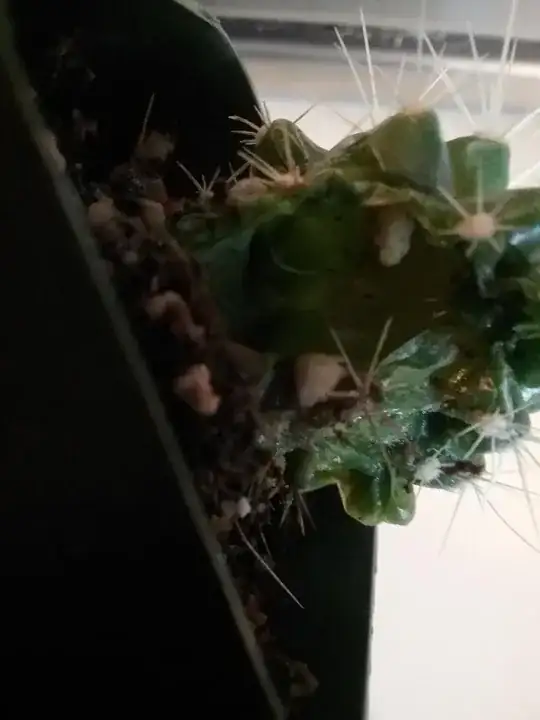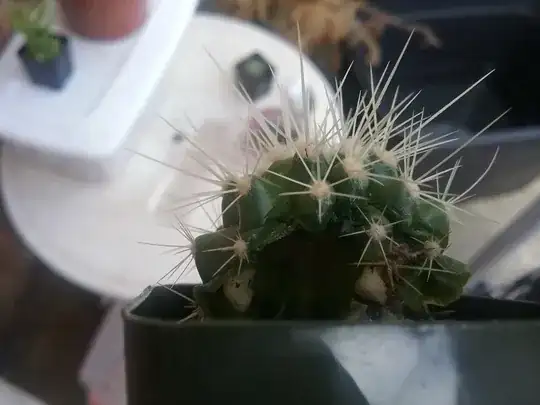
 I recently bought a golden barrel cactus (about two months ago), judging by its size I would say the plant is about a year old. Everything has been perfect with it until Saturday. I usually water or at least check to see if it needs water. On Saturday I noticed the bottom was limp, apon closer inspection the base of the cactus was soggy and googey. There are small bugs inside the cactus, which is now almost compleatly hollowed out. What could thuse be? Please help.
I recently bought a golden barrel cactus (about two months ago), judging by its size I would say the plant is about a year old. Everything has been perfect with it until Saturday. I usually water or at least check to see if it needs water. On Saturday I noticed the bottom was limp, apon closer inspection the base of the cactus was soggy and googey. There are small bugs inside the cactus, which is now almost compleatly hollowed out. What could thuse be? Please help.
- 131
- 4
-
1How often do you water it, generally speaking? – GardenerJ Oct 09 '17 at 17:54
-
Do you keep it indoors or outdoors? Sometimes birds and rodents will leave a hole like this, and may have given an entrance to the bugs. Do you have the close up of the gooey bits? I'm upvoting your question to encourage your ability to post more pics – Christy B. Oct 09 '17 at 19:13
-
I water it about once a week. Only on Saturday or Sunday. Never leave it setting in water. – Alex.M Oct 09 '17 at 20:46
-
I keep it indoors on a high shelf. Thanks for the upvote. Until that happens I'll just edit the pic. – Alex.M Oct 09 '17 at 20:48
-
1Once a month is a good watering schedule for these things. Water too often, and the roots die, while the plant goes all soggy. – Wayfaring Stranger Oct 10 '17 at 14:05
-
In my opinion and experience cactus should be watered when they need it. Need is dependent on the pot material/construction, temperature and humidity, sun exposure, soil/media composition and the needs of the plant. Note that time is nowhere in the list. Cactus are more likely to rot when grown in a rich media. I grow mainly North American cactus and use coir and TurfaceMVP at about 50/50 (not a paid spokesperson). Nothing that can be easily broken down. That said, Echinocactus grusonii is one of the most durable and hearty cactus around, once they get some size on them. – Tim Nevins Oct 11 '17 at 19:27
1 Answers
Why is My Cactus Going Soft? is an article on the Gardening Know How website. It has some pertinent information about this problem for you to read. The following is a quote from part of that article.
Cactus Problems with Fungal and Bacterial Diseases:
Bacteria and fungus are introduced to the plant from openings in the flesh. The open areas may be from insect or animal activity, damage from inanimate objects or heavy weather, such as hail. The action of injury isn’t important, but the damage from fungal spores or bacteria is crucial. Warm, moist conditions accelerate the production of fungi spores and increase bacterial production. Once the organism takes hold in your plant, you will see soft, mushy cactus. Symptoms to watch for include small sunken spots, discolored scabs, round soft areas surrounded by fruiting bodies, and black or other colored dots on the surface of the cacti skin. You may even notice some oozing of your cactus plants.
Treating Cactus Rot Issues:
Cactus problems that have gotten into the root usually result in a slowly dying plant, while topical issues in the upper body can be treated easily. Most cacti respond well to excising the diseased tissue. Use a sharp sterile knife to dig out the damaged flesh and allow the hole to dry out. Don’t water overhead as the wound closes.
If the damage has infected the roots, there is very little you can do. You can try to repot the plant, removing diseased soil and replacing it with sterile soil. You should wash the roots off well before replanting in fresh potting medium.
A soft, mushy cactus can also be saved by taking cuttings and letting them root for a fresh new plant. Allow the cutting to callus over for a few days before you insert it into sand. Rooting the cutting may take several weeks. This method of propagation will produce a healthy cactus that is the same as the parent plant.
- 6,215
- 8
- 39
- 74
- 111
- 2